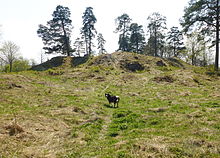|
Pillage of SigtunaThe Pillage of Sigtuna was the raid of the Swedish town of Sigtuna by pagans from the Eastern Baltic in 1187, leading to its destruction.[1] The pillage is most commonly attributed to Estonians, Curonians, Karelians, or Novgorodians.[2] PillageAccording to chronicles, the town of Sigtuna was burned down on 12 August 1187, and Archbishop Johannes of Uppsala was killed at Almarestäket.[3] The killing of Jon Jarl in Asknäs has also been sometimes connected to the attack.[4] Researchers mostly agree that the raid took place, but question the extent of damage and the identity of the attackers.[5] Archeological records from Sigtuna provides no clear evidence of a major attack, no layer of burnt buildings or other evidence has been found.[6] Identity of the raiders The oldest sources mentioning the raid are the Annals of Visby, which describe the attackers simply as heathens.[7] The earliest source to identify the raiders is Erik's Chronicle from 1320s, which describes them as Karelians, but its reliability is not considered very high.[4] Erik's Chronicle was written at the period of Swedish conflict with Novgorod, which at the time included Karelia, so blaming the raid on them may have been a way to justify attacks in the 14th century.[8] Karelians were not normally described as pirates in written sources, and historian Hain Rebas has questioned whether the ships they commonly used on the Lake Ladoga were even suited for sailing to Sigtuna.[6] Additionally, there is no mention of the raid in Russian chronicles, which suggests that the identity of the attackers were not Karelians or Russians.[9] Russian chronicles also do not tell of spectacular naval expeditions conducted by the Novgorodians; instead, there are mentions of merchants and princes visiting countries overseas.[6] In the 1540s, Olaus Petri wrote his Swedish Chronicle, making use of Erik's Chronicle and other sources which do not exist anymore, and he stated that Estonians burned down Sigtuna. Other 16th-century historians, including Laurentius Petri and Johannes Magnus, also attributed the attack to Estonians. Several researches regard this version more reliable, especially as Estonians definitely had ships and ability to sail to Sigtuna.[10] For example, Livonian Chronicle of Henry mentions Estonian raid to Sweden in 1203, and states that such attacks were a common occurrence.[11] 17th-century historian Johannes Messenius mentions the raid in his Scondia illustrata, blaming it in different parts of text once on Curonians and once on Estonians.[11] Some researchers consider Curonian participation possible, as they actively engaged in piracy, and were known to cooperate with Estonians.[7][12] Erik's ChronicleAccording to Erik's Chronicle:
References
Bibliography
|